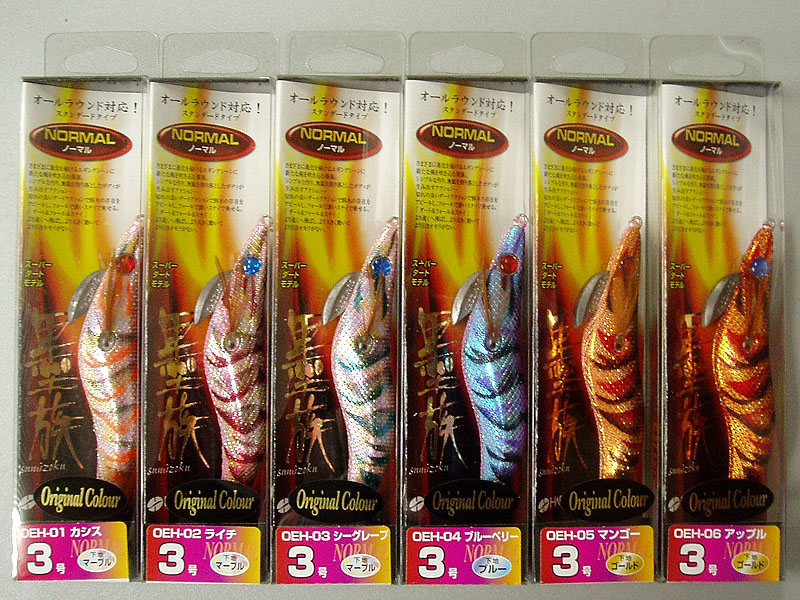Fishing for squid is a fast emerging style of angling which is making waves in Australia. It has been happening in Japan for decades but is only catching on here, now. There is specialist equipment such as; rods, reels, lines, lures (called ‘egi’ in Japan), attractants, gaffs, nets and other accessories.
There was even a 'Calamari Classic' competition just a few weekends ago here in Perth. Japanese squid tournament anglers were present at the weigh-in. One of them provided an amazing insight; not only into the tackle used, but also the techniques that catch you more squid. Hopefully by the end of reading this 'How to' you will have learnt more about how to catch squid in your local area.
Where:
Squid are an aggressive species and generally abundant in inshore areas. The best places to find them are areas with a combination of weed beds and sand. If there is weed around there will usually be squid. The only downside to squid is that they carry a load of black ink that they expel if threatened. Many a squid angler has been sprayed with the squidy stuff and it stains any fabric permanently. If you happen to be shore-based a good tip is to look for ink splatters on jetties, wharves and other permanent structures. When looking for good ground just remember; ‘no weed, no squid’.
Tackle:
Australian squid fishing usually revolves around collecting them for bait (for which they are excellent) or throwing the occasional jig or baited spike when one is sighted while targeting other species. Many people catching squid just use a handline, however with the amount of specialist tackle trickling in from Japan, there now are more effective ways to get your bag limit.
Outfits for squid can range from your average handline all the way up to the +$1000 specialist rods, matched to a high-end reel, spooled with light braid or fluorocarbon line. If you are really serious about catching squid then a good starting point is a specialist rod. This is a crucial part of your gear as a good squid rod is different to most typical rods on the market. The specialist ones feature parabolic actions when loaded, however are fairly stiff also fairly stiff. The better ones are over 8 feet long, sport the Fuji ‘Low-rider’ guides, made on high modulus graphite blanks and often feature split-grip style handles.
These rods, due to their length and guides, can propel a 2.0 – 4.0 squid jig a fair distance; somewhere around 80m by the accounts of the Japanese pros. The parabolic taper means that the hooks of the squid jig are less likely to pull from the soft tentacles of the squid and the stiffness of the blank is required for the aggressive jerking action used when working the squid jig.
Reels don’t need to cost a fortune and “good things not cheap” but again the more it costs the better it will be. The only necessity is a reel with a smooth, consistent drag. As for line; braided line is often used due to its thin diameter for increased casting distance and low stretch for un-snagging your jig. This is supplemented by a long clear fluorocarbon leader of about one or two meters.
There is a large range of squid jigs around and most will catch squid, however the more expensive ones do ‘out-squid’ the cheapies. Brands to look out for are Harimitsu Sumizoku, Yamashita, Yo-Zuri and Daiwa Emeraldas. All of these feature ultra-sharp hooks on the rear and a superb action in the water. The jigs aren’t cheap and range from $12 to $30, but when you fish alongside a mate who is using the cheap versions and catch more than them you’ll be sold.
The colour of the jig is important to many anglers, and there are many different theories regarding what is best when. A good general rule is bright oranges, reds and pinks in cloudy or low light periods; through to blues, greens, browns and other ‘natural’ colours in sunny and daytime situations. Clear water is better and calm conditions also help.
Now that you have all the right gear and know where you can find some squid the only other factor is your ability to work the jig correctly. This is where many people get stuck. The correct technique was demonstrated to me by the Japanese tournament angler at the Calamari Classic and it has significantly improved my catch rate. The words which best describe the required rod action is hard, sharp and fast. When observed it is really fairly simple.
1. Cast the jig as far as possible (or to any weed banks you can see).
2. Let it sink till it is very near or on the bottom.
3. Take up any slack
4. Slam the rod tip up several times while still winding.
5. Now here is the important part. After your last jerk you MUST completely stop everything and let the jig sink again as squid rarely hit a fast moving jig.
6. Once the jig is near the bottom again, take up the slack.
7. If you feel weigh lift the rod smoothly or go to step 4 and repeat.
8. If you have a squid you will feel heaviness and a surging and pulsing of the rod tip.
9. All that is required once the squid is hooked is constant pressure and a steady retrieve.
The pause is the crucial part of the retrieve. In the sunny, bright conditions of summer the jerk can be toned down a little but in winter (when the squid spawn and are most aggressive) feel free to really work it. Similar cast and retrieve methods can be employed from boat or kayak.
http://www.youtube.com/watch?v=rnPRmruMWt0
http://www.youtube.com/watch?v=8BrCj...eature=related
http://www.youtube.com/watch?v=XqWCt...eature=related
Remember the heads and tentacles are great bait for a variety of species such as Snapper and King George Whiting. To clean the squid they must first be semi frozen first. This makes removing the tough skin and flaps easier. Remove the insides with the head and then google a squid recipe. Apparently they are great when marinaded in crushed kiwi fruit.
So get out there and go catch yourself a feed of squid but only take what you need.
Welcome guest, is this your first visit? Create Account now to join.
Welcome to the ActiveAngler.
Search Forums
Results 1 to 8 of 8
Thread: How to catch squid.
-
26-05-2009, 10:17 PM #1
 How to catch squid.
How to catch squid.
-
27-05-2009, 08:58 AM #2

Good post mate.
Yo-Zuri squid jigs all the way for me.
They were by far the best for me always.
Pete
-
27-05-2009, 05:33 PM #3

yeh top post mate, i use a handline with a razorback jig and norm get a feed, one day ill upgrade to a rod and reel
-
28-05-2009, 08:59 AM #4
-
28-05-2009, 05:49 PM #5

Great post Echo, and I do like my squid, lightly seasoned or a light batter - and fresh is a must!!!
I've been using the kiwi fruit for awhile, but i haven't used it as a marinade as such, rather, I marinade it with slices of the fruit as it contains a protien called 'Pectin' from memory which makes the squid more tender. Before cooking, I then remove the kiwi, and prepare for cooking with either season or batter depending on what I feel like. So I find that i use the kiwi to make it more tender, rather than taste.
Hmm, now I'm hungry.
Cheers NathIt's not about the fish, it's about fishing!
Real men wear PINK!

-
28-05-2009, 10:38 PM #6

Oh and I almost forgot...
This squid came from the kiosk area at the North Mole for all you Perth squiddersLast edited by echo1; 28-05-2009 at 10:40 PM.
-
03-06-2009, 08:18 PM #7

I'd love to have a fish with one of the top line Jap guys. Interesting that you recommend a sharp jigging action, quite different to what I habitually use after spending time with some professional squid fishers down here (yeah most of the professional calamari fishers down this way hand jig - ie with a rod and reel- the same as the amateurs rather than nets as opposed to the arrow squid boats that tend to use automated jigging machines) who recommend a smooth jigging action.
Also just a note that the spawning is certainly not confined to winter there are many species of squid and each will be different - the main ones targetted recreationally in australia are southern and northern calamari and arrows (of these only arrows are specifically attracted to lights though the others will still hunt around lighted areas due to the baitfish the lights attact). Southern Calamari like that in your pic live 6-8 months and are terminal serial spawners so there is typically a winter and summer population with an extended spawning season with multiple peaks. Here in Tas. in the best studied region, the peak spawning periods runs from about november to march (biggest) and from may to august with the biggest specimens present in late summer as these are the animals that have benefitted most from high water temps. Something obvious to look for too is snow-white patches in amongst the darker seagrass beds as these are egg masses indicating that active spawning squid won't be far away. If you find egg masses washed up on the beach this is also an obvious sign to break out the jigs.
Also its worth noting that most squid are colour blind but still have excellent vision and can in fact see polarization. Shade sensitivity is also acute.
Finally most squid species are very poor at osmoregulation and so will stick to very close to pure seawater and as they are primarily visual predators (roughly 70% of the brain is involved in visual processing) they prefer clear water too. Chemical detection is relatively poor (compared to fish) but they also have both the ability to hear and a sense analogous to the lateral line of fish.
Also the best way to avoid being "inked" is to hold the squids head and the front of the body out of the water until all water in the mantle cavity has been expelled as the ink from the sac must be mixed with water to be squirted.
Incidentally if anyone knows a method of avoiding arrow squid when they are around I'd love to hear it.
col.
Just a couple of different squid species: southern calamari, dumpling squid, arrow squid (arrow is not my photo).
-
09-06-2009, 01:59 PM #8

We got a heap of squid yesterday on the kanji clicks 3.0 . Dynamite jig but again not cheap. Ended up releasing them all as we forgot the bucket! Felt strange releasing them but they all go back really well. Im sure ill be shot for saying that :P










 Reply With Quote
Reply With Quote

